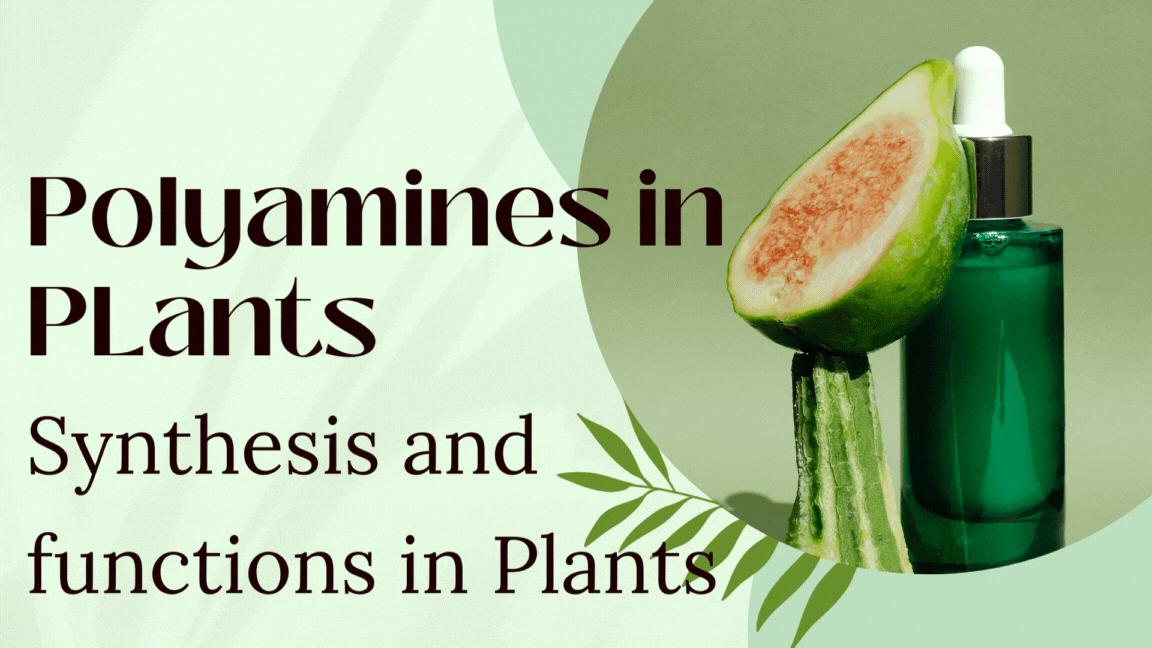
Polyamines, such as putrescine, spermidine, and spermine, are critical regulators of plant growth, development, and environmental stress adaptation. These small, organic molecules interact with nucleic acids, proteins, and membranes, influencing various biological processes. Current research is intensifying around polyamine biosynthesis due to their potential to enhance crop resilience, productivity, and stress tolerance in the face of climate change. Recent genome-wide studies in various plant species, including citrus, have deepened our understanding of polyamine biosynthesis genes and their regulatory mechanisms. This review will cover the key pathways, functions, and emerging research trends in polyamine biosynthesis, with a particular focus on its agricultural implications.
Biosynthesis Pathways: Molecular Mechanisms
Polyamine biosynthesis in plants begins with the decarboxylation of precursor amino acids like arginine and ornithine, through two primary pathways:
- Arginine Decarboxylation Pathway:
- Arginine Decarboxylase (ADC) converts arginine into agmatine.
- Agmatine is hydrolyzed by agmatine iminohydrolase (AIH) to produce N-carbamoylputrescine, which is subsequently converted into putrescine by N-carbamoylputrescine amidohydrolase (CPA).
- Ornithine Decarboxylation Pathway:
- Ornithine Decarboxylase (ODC) decarboxylates ornithine directly into putrescine, an alternative pathway that is less prominent in plants.
Once putrescine is synthesized, it is converted into higher polyamines:
- Spermidine Synthase (SPDS) catalyzes the addition of an aminopropyl group to putrescine, forming spermidine.
- Spermine Synthase (SPMS) further converts spermidine into spermine, using decarboxylated S-adenosylmethionine (dcSAM) as the aminopropyl donor.
Genome-Wide Identification of Polyamine Biosynthesis Genes in Citrus unshiu
Recent advancements in genome-wide analyses have allowed researchers to identify and characterize key genes involved in polyamine biosynthesis in various plant species. A notable study was conducted on Citrus unshiu (Satsuma mandarin), an economically significant citrus species widely cultivated for its fruit.
Through a genome-wide identification and characterization of the polyamine biosynthesis gene family in Citrus unshiu, researchers identified 13 polyamine biosynthesis genes responsible for the production of putrescine, spermidine, and spermine. This study revealed that the expression of these genes is differentially regulated under various environmental stresses, such as drought and salinity. Notably, genes encoding ADC and ODC showed increased expression in response to abiotic stress, indicating their critical roles in enhancing stress tolerance. This comprehensive analysis provided valuable insights into the functional roles of polyamines in Citrus unshiu and serves as a foundation for future research aimed at improving stress resilience in citrus crops.
The identification of these genes in Citrus unshiu is particularly significant because citrus crops are highly sensitive to abiotic stresses. By understanding the molecular mechanisms regulating polyamine biosynthesis in citrus, researchers can develop targeted strategies to improve stress tolerance and enhance citrus yield under adverse environmental conditions.
Polyamines: Multifunctional Roles in Plants
Polyamines are involved in numerous processes vital for plant survival and productivity:
- Cell Growth and Development:
- Polyamines are key regulators of cellular functions, including DNA stabilization, protein synthesis, and membrane integrity, all of which are critical for cell division and tissue growth .
- Abiotic Stress Tolerance:
- Polyamines play a protective role in plants under environmental stresses, including drought, salinity, extreme temperatures, and oxidative stress. Their ability to stabilize membranes, scavenge reactive oxygen species (ROS), and regulate ion transport makes them crucial for stress tolerance .
- Reproductive Development:
- Polyamines are essential for reproductive success, influencing flower formation, fruit set, and seed development. Elevated polyamine levels have been linked to improved fruit quality and yield in crops such as tomato and citrus .
- Defense Against Pathogens:
- Polyamines can act as signaling molecules that regulate plant defense mechanisms against pathogens, by inducing the expression of defense-related genes and proteins. Their role in modulating both innate and induced immune responses is gaining attention as a potential tool for enhancing plant immunity.
Current Trends in Polyamine Research
With the growing need for sustainable agricultural practices and climate-resilient crops, polyamines are being investigated for their potential to enhance crop performance under stress conditions. Several key research trends are emerging in this field:
- Genetic Engineering for Polyamine Enhancement:
- Gene Editing and CRISPR Technology: Recent advancements in CRISPR/Cas9 and other gene-editing technologies are being used to target polyamine biosynthesis genes. Modifying key enzymes like ADC, ODC, and SAMDC has been shown to enhance polyamine accumulation, leading to improved stress tolerance in crops like rice, wheat, and maize. Transgenic plants overexpressing these enzymes show enhanced resilience to abiotic stresses, such as drought and high salinity.
- Polyamine Metabolism Manipulation: Studies have shown that altering polyamine catabolism, by targeting enzymes like polyamine oxidase (PAO), can regulate polyamine levels during stress responses. Fine-tuning polyamine turnover could be an effective strategy to enhance plant adaptation to fluctuating environmental conditions.
- Exogenous Application of Polyamines:
- Biostimulants in Agriculture: The application of exogenous polyamines as biostimulants is a growing trend, particularly in horticulture. Foliar sprays and soil treatments with polyamines are being explored to enhance growth, yield, and stress tolerance. These applications have been tested in crops like tomatoes, wheat, and citrus with promising results in improving drought resistance, fruit set, and overall plant health.
- Integrated Stress Management: Polyamine-based formulations are being integrated into crop management programs aimed at mitigating multiple stress factors (e.g., water deficit, heat stress). This approach seeks to maximize polyamine benefits in combination with traditional fertilizers and other plant growth regulators.
- Polyamines and Epigenetic Regulation:
- Epigenetic Modifications: Emerging research suggests that polyamines may play a role in epigenetic regulation by influencing DNA methylation, histone modifications, and chromatin remodeling. This is particularly relevant in the context of stress memory, where plants “remember” past stress events and modulate their response in subsequent stress conditions. Understanding the interaction between polyamines and epigenetic mechanisms could open new avenues for enhancing stress tolerance through epigenetic breeding.
- Polyamines and Plant Microbiomes:
- Plant-Microbiome Interactions: Polyamines have been implicated in shaping plant-microbe interactions, both in the rhizosphere and endophytic communities. Recent studies indicate that polyamines may modulate the composition of beneficial microbial communities, influencing nutrient uptake and disease resistance. This area of research is gaining attention for its potential to enhance sustainable agricultural practices by optimizing plant-microbiome interactions.
- Omics Approaches in Polyamine Research:
- Metabolomics and Transcriptomics: High-throughput techniques such as metabolomics and transcriptomics are being employed to unravel the complex regulation of polyamine metabolism. These approaches are helping to identify new polyamine-related genes and metabolites involved in stress responses, providing a systems-level understanding of how polyamines interact with other metabolic pathways.
Future Directions
As research on polyamine biosynthesis and its regulatory networks continues to advance, several exciting prospects are on the horizon:
- Precision Agriculture: By integrating polyamine research with digital farming technologies, real-time monitoring of polyamine levels in crops could enable precision interventions to optimize stress responses and enhance yields.
- Polyamine-Linked Breeding Programs: Breeding programs focusing on polyamine-related traits, combined with marker-assisted selection (MAS) and genomic selection, could significantly accelerate the development of climate-resilient crop varieties.
Conclusion
Polyamines have emerged as critical regulators of plant growth, development, and stress response. With increasing global demand for climate-resilient agriculture, polyamine research offers promising solutions to enhance crop productivity and sustainability. Current trends in genetic engineering, biostimulant application, and epigenetic studies underscore the potential of polyamines to revolutionize modern agricultural practices. By harnessing the power of these small yet powerful molecules, the future of agriculture could see crops better equipped to withstand the environmental challenges ahead.
References:
- Saleha Sadiq et al. (2023). Genome-Wide Identification and Characterization of the Biosynthesis of the Polyamine Gene Family in Citrus unshiu.
- Gill, S. S., & Tuteja, N. (2010). Polyamines and abiotic stress tolerance in plants. Plant Signaling & Behavior, 5(1), 26-33.
- Alcázar, R., et al. (2010). Polyamines: molecules with regulatory functions in plant abiotic stress tolerance. Biotechnology Advances, 28(3), 424-433.
- Mattoo, A. K., et al. (2010). Polyamines and fruit ripening. In Plant Hormones: Biosynthesis, Signal Transduction, Action!, Springer, pp. 565-589.
- Bouchereau, A., Aziz, A., Larher, F., & Martin-Tanguy, J. (1999). Polyamines and environmental challenges: recent developments. Plant Science, 140(2), 103-125.
- Liu, J. H., Wang, W., & Yao, Q. H. (2006). Effect of exogenous polyamines on the drought tolerance of apple seedlings. Plant Growth Regulation, 49(3), 239-248.
- Walden, R., et al. (1997). Polyamines: small molecules triggering pathways in plant growth and development. The Plant Journal, 11(5), 1071-1081.




Molecular Farming In Biotechnology: Transforming Agriculture And Medicine
[…] Polyamine Biosynthesis in Plants: Mechanisms, Functions, and Cutting-Edge Research Trends […]